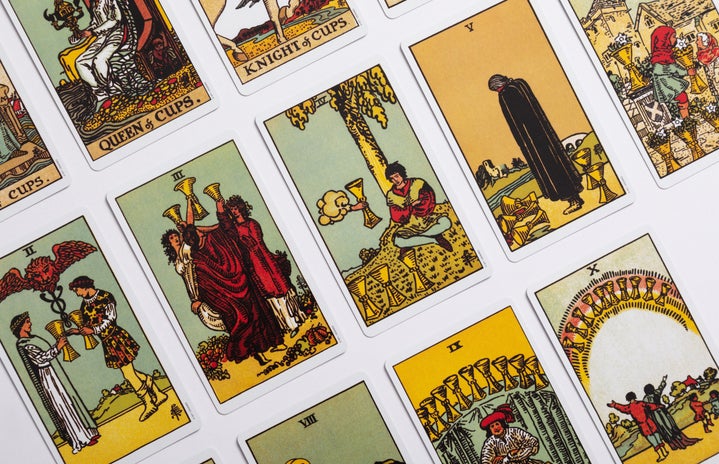Tarot cards have long captivated people’s imaginations with their enigmatic symbols, predictions and mystical allure. Used for divination, personal insight and even as a source of creative inspiration, tarot can offer a lot to those willing to explore its meanings. Halloween and the fall season always make me want to get in touch with my spiritual side and embrace the comfort that tarot reading brings me, both doing readings for myself and for my friends.
The origins of tarot are shrouded in mystery, but tarot cards are believed to have emerged in the 15th century in Europe. Originally, tarot decks were used for playing card games, similar to modern-day playing cards. However, over time, the tarot evolved into a powerful tool for divination and personal growth.
A standard tarot deck consists of 78 cards, divided into two main categories: the Major Arcana and the Minor Arcana. The Major Arcana is made up of 22 cards. These cards represent major life events, spiritual lessons and significant influences. Examples of Major Arcana cards are The Fool, The High Priestess, The Empress and The Tower. The Minor Arcana is 56 cards. The Minor Arcana is divided into four suits—Cups, Swords, Wands and Pentacles, each with ten numbered cards and four court cards (Page, Knight, Queen and King). These cards address more day-to-day matters and emotions.
Tarot cards are typically not inherently “good” or “bad.” Instead, their interpretation depends on the context of the reading, the question asked and the surrounding cards. Tarot cards are symbolic and can have multiple meanings. However, some cards are often associated with positive or challenging aspects.
Positive:
The Sun: Represents happiness, success and enlightenment.
The Star: Symbolizes hope, inspiration and spiritual guidance.
The Wheel of Fortune: Suggests positive changes and good luck.
The Ten of Cups: Represents emotional fulfillment and happiness in relationships.
The Ace of Cups: Signifies new beginnings in love and emotional well-being.
Negative:
The Tower: Symbolizes sudden and disruptive change or upheaval.
The Devil: Represents temptation, bondage or unhealthy attachments.
The Three of Swords: Indicates heartbreak, sorrow or emotional pain.
The Five of Pentacles: Suggests financial hardship or feeling left out in the cold.
The Ten of Swords: Symbolizes hitting rock bottom or experiencing a painful ending.
It’s important to remember that the interpretation of a tarot card can vary depending on the reader’s intuition, the specific question being asked and the other cards in the spread. It’s also essential to approach tarot with an open mind and not solely rely on it for decision-making.
Performing a tarot reading is a personal and intuitive experience. It can look different for everyone, and there is no clear guide or wrong answers. Usually, my first step for tarot is setting the mood. Find a quiet, peaceful space to perform your reading. Lighting a candle or playing soft music can help create the right atmosphere and help you from getting distracted. Concentrate on your question or intention for the reading while shuffling the cards. Some readers have specific rituals for shuffling, while others simply focus on their query. The trick is to trust the cards with your intentions.
You can use different card layouts, called spreads in tarot, depending on the nature of your question. The most common is a simple three-card spread, which can provide past, present and future insights. More complex spreads offer more detailed answers. Each card in your spread has its unique symbolism and meaning. Consult tarot guidebooks or resources to learn about these meanings. Every tarot deck comes with a guidebook, and that is an important tool in interpreting the meaning behind the card and understanding the basics. However, trust your intuition, as personal interpretations are essential in tarot readings.
Details are important, and although tarot does not always provide exact answers, it can be used as a tool for interpreting your emotions and the world around you. Pay attention to the relationships between the cards in your spread. Cards placed next to or in opposition to each other can offer additional insights. After interpreting the cards, take time to reflect on the message they convey and how it relates to your question or situation.
The premise of tarot is taking whatever resonates. Not every single description of what a card stands for may feel accurate, but usually, the cards offer something that you can reflect on. Oftentimes, a reading may not give you the answer you were looking for, or you may have to read between the lines. Tarot is not a magic eight ball, it will not give you a clear answer or solution and sometimes that can be frustrating, especially when you are still getting familiar with the cards.
Tarot readings can offer guidance, but it’s essential to remember that your choices and actions shape your future, not the cards. The tarot is simply a tool to assist, not dictate, your life’s path.
Tarot is a versatile and fascinating tool for self-discovery, reflection and gaining insights into life’s complexities. As you delve deeper into tarot, you’ll discover that it’s not about predicting the future with certainty, but about understanding the present and empowering you to make informed choices. With practice and patience, you can unlock the mysteries of the cards and embark on a journey of self-discovery and personal growth.


